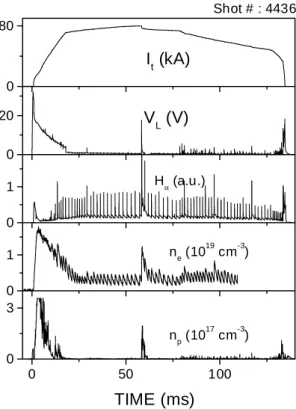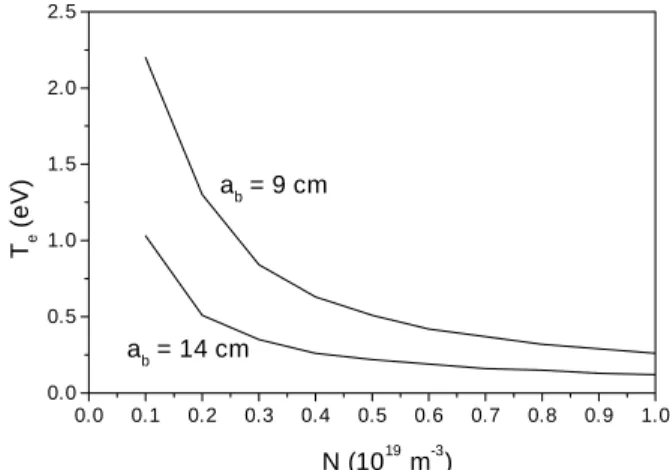Plasma Reombination in Runaway
Disharges in Tokamak TCABR
T.K. Soboleva 1
, R.M.O. Galv~ao 2
,S.I. Krasheninnikov 3
,
Yu.K. Kuznetsov 2
, and I.C.Nasimento 2
1
InstitutodeCienias Nuleares,UniversidadNaionalAutonomiade MexioD.F.,Mexio
2
Instituto deFsia,UniversidadedeS~aoPaulo,
C.P.66318, 05315-970,S~aoPaulo,Brasil
3
UniversityofCalifornia,SanDiego,USA
Reeivedon26June,2001
Anewregimeofrunaway dishargeshasbeenobservedintheTCABRtokamak. Oneofthemost
distintivefeaturesofthisregimeistheeetofplasmadetahmentfromthelimiter. This
experi-mentalfatanonlybeexplainedbythevolumereombination,whihrequiresalow-temperature
plasma. Theanalysisoftheenergyandpartilebalaneinthesystemplasma-relativisti runaway
beaminTCABR,whihtakesintoaountonlytheollisionalmehanismoftheheattransferfrom
runaways tothermal eletrons,predits eletrontemperatures Te =0:1 2eV; the temperature
dereases with the neutral density inrease. The reombination proess with the rate onstant
around10 16
m 3
/sis requiredforthe explanationof plasmadensity behavior intheexperiment.
At present, it isdiÆult to onlude about the mehanismof reombination. More reliable and
detailedexperimentaldata,mainlyabouttheplasmatemperature,areneessary.
I Introdution
Anewregimeofrunawaydishargeshasbeenobserved
in TCABR tokamak [1℄, with major plasma radius
R = 0:615 m, minor radius of the limiter a = 0:18
m,toroidalmagnetieldB =1:1T.Oneofthemost
distintivefeaturesofthisregime,omparedto
onven-tional runawaydishargesintokamaks[2℄,istheeet
of plasma detahment from the limiter. This
experi-mental fat anonly beexplainedby athevolume
re-ombination,whihrequiresalow-temperatureplasma.
The present work is regardedto the questionon how
theexisteneofareombinativeplasmaagreeswiththe
energyandpartilebalaneinthepreseneofan
inten-siverelativistibeamof runaway eletrons. Themain
experimentaldatarelatedtothistopiarepresentedin
Setion II.Theanalysisof energyand partilebalane
is performedin Setion III.Theonlusion is givenin
Setion IV.
II Experimental data
A learindiation of the reombinative plasmain the
runawaydishargesobservedinTCABRistheeetof
plasmadetahmentfromthelimiter. Theplasma
den-sityinthesrape-olayer(SOL),measuredbya
Lang-muir probe, starts to derease at the start-up phase
At the same time, the line density measurements by
theinterferometer along dierent vertial hords
indi-ate a shrinkage of the plasma olumn. Indeed, the
plasmaolumn isshifted outward, due to thehigh
ki-neti energy of runaways, and its minor radius is
es-timated from these measurements to be in the range
0:09m a
p
0:14 m. These experimental fats an
be explained only by volume reombination in a
low-temperature plasma. Suh plasma exists in the
run-away disharges due to the low heating power.
Sim-ple estimations indiate that resistive fration of the
plasmaurrent and thus the ohmi heatingpowerare
negligiblesmallatloweletrontemperaturesT
e
<5eV.
Thepowertransferredollisionallyto theplasmafrom
therelativistilow-densityrunawaybeamisalsorather
small. Thelow-temperaturereombinativeplasma
de-tahed from the limiter is kept in equilibrium by the
runawayurrent.
Other distintive feature or this regime is the
re-laxation instability with strong spikesin H
emission
orrelatedwithsawtoothrelaxationofthelinedensity
(seeFigs1and2). Plasma-beaminstabilitiesan
pro-vide an additional plasma heating hannel. We
on-ludefrom theexperimentaldata thatplasma heating
ours in short pulses. Expanding a singlesawtooth,
0
50
100
0
3
Shot # : 4436
n
p
(10
17
cm
-3
)
TIME (ms)
0
1
n
e
(10
19
cm
-3
)
0
1
H
α
(a.u.)
0
20
V
L
(V)
0
80
I
t
(kA)
Figure1. AnexampleoftherunawaydishargeinTCABR
tokamakwiththeeetofplasmadetahmentfromthe
lim-iter. Parameters presented here are the toroidal urrent,
loopvoltage, H
a
emission, line density for entral vertial
hordaveragedonthelimiterdiameterof0.18m,loal
den-sitymeasuredinSOLbyLangmuirprobe.
40
42
44
46
48
50
0
1
E
C
E (a
.u.)
n
e
(10
19
m
-3
)
H
α
(a
.u.)
V
L
(V)
TIME (ms)
0.0
0.8
0.0
0.4
Shot # : 4436
0
3
78
79
I
t
(k
A
)
Figure2. Expandedspikesrelated tothe relaxation
insta-bilityinthetimewindow40-50msforthedishargeshown
inFig.1. Eletronylotronemission(seondharmoni)is
alsopresented.
beexplainedbyatemperatureinreasetoT
e
15eV,
takingintoaountthattheneutraldensityinthisase
is around 10 19
m 3
. Spikesin H
; eletronylotron
andX-rayemissionsandnegativevoltagespikes,whih
weonsideredasonesrelatedtotheinstabilityproess,
our in time intervalsof tensmiroseonds. Then it
seemsthattheinstabilityisquenhed,theplasma
tem-peraturedropsandthedensitydeaysdueto
reombi-nation.
ExperimentswithgaspuÆngonrm themodelof
low-temperature plasma and give an additional
infor-mation about this regime. The runaway disharge is
muh more stable with respet to the gas puÆng as
omparedtothenormalone. Themaineetsobserved
under inrease of the neutral density, up to 510 19
moleules/m 3
; aretheinreaseof thefrequenyof the
spikesinallsignals,inreaseoftherateofdensitydeay
in therelaxationproess, anddereasein therunaway
urrentandbakgroundplasmadensity.
Currently, we haveno diret measurementsof the
plasma temperature, whih are diÆult due to the
ef-fetofrunawaybeam. Estimationsoftheeletron
tem-peratureintheRADanbeobtainedfromthedeayof
positivevoltagespikes[3℄. This method giveseletron
temperatures0.2-1.5eV[4℄.
Theaverage runawayenergyisdedued from
equi-librium eets. The value of the beta poloidal is
de-terminedfrommagnetidiagnostis. Thentheaverage
energyofrunawaysisestimatedfromthevalueofbeta
poloidalusingtheformula[3℄
p =
I
A I
b
I 2
t
where I
A (kA)
= 17
p
2
1istheAlfvenurrentand
istherelativistifator. Inourase,I
b
= I
t
:Forthe
dishargepresentedin Fig. 1, we obtain,at the quasi
stationary phase, 9, whih orresponds to kineti
energyof4MeV.
III Energy and partile balane
alulations
The plasma is transparent to neutrals in our
ondi-tions. For simpliity, let us onsider zero-dimensional
transportmodel. Energybalaneequationsforthermal
eletronsandionsare
3
2 n
e dT
e
dt =Q
oh +Q
b Q
en Q
ei
(1)
3
2 n
i dT
i
dt =Q
ei Q
in
(2)
where Q are heat uxes aused by ohmi
heat-ing (Q
oh
), runaway-thermal eletrons (Q
b
),
ollisions. Q
b
hastheform
Q b = e 4 n b n e ln b 4" 2 0 m e (3)
whereCoulomblogarithmisapproximatelyln
b =20:
Weassumen
e =n
i
,i.e. theeetiveionhargeZ
i =1.
Forrelativistirunawaybeam,the runawaydensityis
n b = I b =ea 2 b ; a b
is the beam minor radius. The
runawaybeamdominatesin thetotaltoroidal urrent
I t =I b +I p
; i.e.,weanassumeI
b
= I
t
: Theresistive
(plasma) urrent I
p
is small due to the low valuesof
the loopvoltageand eletrontemperature. The
diu-siveenergylossesarenegleted.
The stationary eletron temperature alulated
from Eqs. (1) and (2) is presented in Fig. 3. Here
weusefor theplasmaradius a
p =a
b
=0:09 0:14m
taking into aount results of hord density
measure-ments. One ansee from Fig. (3) that the ollisional
proessgivesT
e
=0:1 2eVforindiatedbeam-plasma
parameters; T
e
dereases with the neutral density
in-rease. Ohmiheating isneligiblesmall atT
e
<5eV.
Energylossesduetoeletron-ionandion-neutral
olli-sionsdominateatT
e
.2eV.
Attheplasmatemperatures0.1- 2eV,the
mole-ular ativated reombination (MAR) [5,6℄an explain
thedensitybehaviorintheexperiment. Alargeamount
ofhydrogenmoleuleshastobeinthedishargedueto
reyling ofneutralsat thewallswhere atomi
hydro-gen is eetively onverted to moleular oneand also
due to the gas puÆng. Weonsider equations for the
densityofmoleularandatomiions:
dn m i dt =K b n b N K DR n m i n e n m i (K b D n b +K D n e ) (4) dn a i dt =n m i (K b D n b +K D n e ) K MAR Nn a i (5) n m i +n a i =n e (6) whereK b
isthe rateonstantofneutral ionizationby
runawayeletrons, K
DR
is therate onstantof
disso-iative reombination, K b
D
is the rateonstantof H +
2
dissoiationbyrunaways,andK
D
istherateonstant
ofH +
2
dissoiationbyplasmaeletrons.
0.0
0.1
0.2
0.3
0.4
0.5
0.6
0.7
0.8
0.9
1.0
0.0
0.5
1.0
1.5
2.0
2.5
a
b
= 9 cm
a
b
= 14 cm
T
e
(eV
)
N (10
19
m
-3
)
Figure3. Stationary eletrontemperaturealulated from
Eqs. (1)and(2)asfuntionoftheneutraldensity.
Thesolutionis:
n e n b = K b K D K MAR K b D 2K MAR (K DR +K D ) + s K b K D K MAR K b D 2K MAR (K DR +K D ) 2 + K b (K b D +K MAR N=n b ) K MAR (K DR +K D ) (7) d
FromEq. (7)forK
b K DR K b D K D 10 14 m 3 /s, K MAR 10 16 m 3
/s and N=n
b
100 we nd
n
e =n
b
50: That meansthat stationary plasma
on-entrationisabout510 18
;whihisinagreementwith
that observedin theexperiment.
Other parameter for omparison with the
experi-mentistherateofdensitydeayobservedinrelaxation
instability. Intheaseof MAR,therequiredrate
on-stantis K MAR = dn e =dt n e n m
Forthedishargeshown in Fig. 2,(dn =dt)=n 500 s 1 andn m 10 19 m 3
;wendK
MAR
0:510 16
m 3
/s, whih is a reasonable value of this parameter
[5,6℄.
However,there exists aserious problem in this
in-terpretationofexperimentaldata. TheMARrate
ru-ially depends on vibrational exitation of hydrogen
moleules [5,6℄. In the ase of no vibrational
exita-tion,theMARrateisnegligiblysmall. Inourase,the
plasma is rather transparentand moleules an loose
vibrationalexitation duetoollisionswiththewalls.
Therateofthedensitydegradationobservedinthe
three-bodyreombinationat T
e
.0:1eV.Existene ofsuh
low-temperature plasma in our experiments disagrees
with the energy balane alulations for neutral
den-sitylessthan10 19
m 3
andalsowiththetemperatures
deduedfromthevoltagespikeanalysis.
Thus, an additional experimental data, mainly on
theplasma temperature, are neessaryto reah a
er-tainonlusionaboutmehanismofplasma
reombina-tionintheseexperiments.
IV Conlusion
Theanalysis ofthe energyand partilebalanein the
system plasma-relativisti runaway beam in TCABR,
whihtakesintoaountonlytheollisionalmehanism
oftheheattransferfromrunawaystothermaleletrons,
predits the eletron temperatures T
e
= 0:1 2 eV;
thetemperaturedereaseswiththeneutraldensity
in-rease,N =(0:1 1)10 19
m 3
. Ohmiheatingis
neg-ligiblesmall and energylosses dueto eletron-ionand
ion-neutralollisionsdominateat theseparameters.
Theionization by runaway eletronsdominates at
T
e
< 2 eV. The reombination proess with the rate
onstantaround10 16
m 3
/sisrequiredforthe
explana-tionofplasmadensitybehaviorintheexperiment. At
of reombination. More reliable and detailed
experi-mentaldata,rstofallabouttheplasmatemperature,
areneessary.
Aknowledgment
This work has been supported by FAPESP and
by the Brazilian Ministry of Siene and Tehnology
throughthePRONEXProjets.
Referenes
[1℄ R.M.O. Galv~ao, Yu.K. Kuznetsov, I.C.Nasimento et
al.,PlasmaPhys.Control.Fusion,43,1181 (2001).
[2℄ H. Knoepfel and D.A. Spong, Nul. Fusion 19, 785
(1979).
[3℄ I.ElChamaaNeto,Yu.K.Kuznetsov,I.C.Nasimento,
R.M.O.Galv~ao,andV.S.Tsypin,Phys.Plasmas7,2894
(2000).
[4℄ Yu.K.Kuznetsov,I.C.Nasimento,R.M.O.Galv~aoand
V.S.Tsypin,submittedforpubliationinBraz.J.Phys.
[5℄ S.I.Krasheninnikov,A.Yu.Pigarov,andD. J.Sigmar,
Phys.LettersA214,295(1996).
[6℄ A.Yu. Pigarov and S.I. Krasheninnikov, Phys. Lett.

